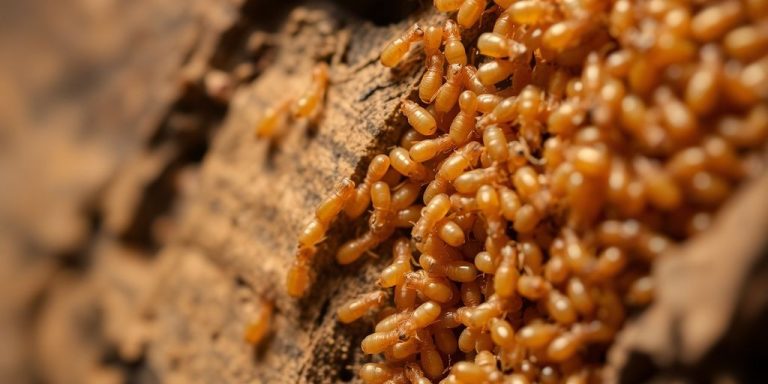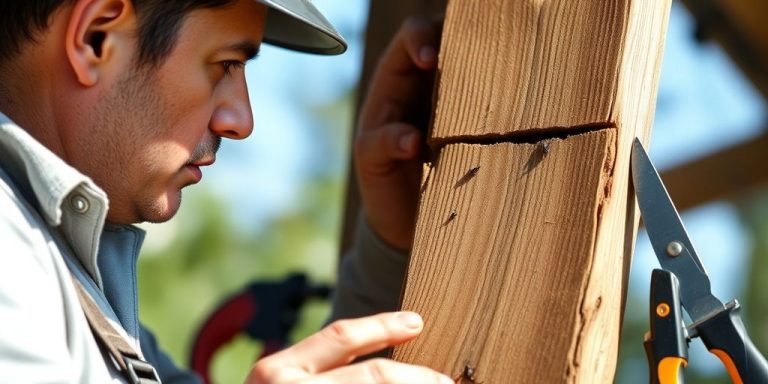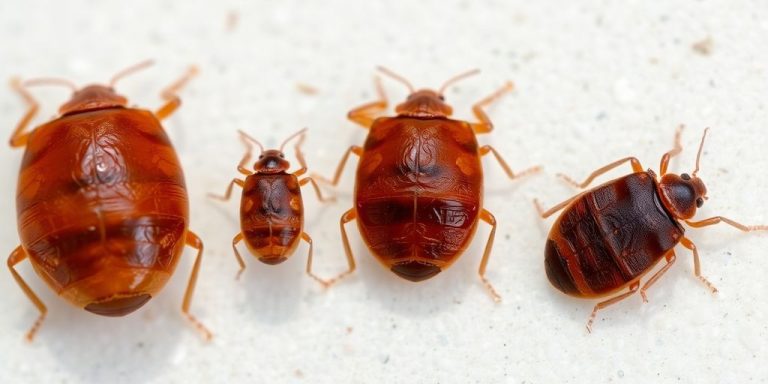Ever wondered how bed bugs go from tiny eggs to a full-blown infestation in your home? It’s not magic, but it sure feels like it. These little critters have a life cycle that helps them multiply fast if not caught early. Understanding their journey from egg to adult can help you spot the signs of an infestation before it gets out of hand. Let’s break down the bed bug life cycle, so you know what you’re dealing with.
Key Takeaways
- Bed bugs start their life as tiny eggs, often hidden in cracks and crevices.
- Nymphs hatch from the eggs and need blood meals to grow and molt.
- Adult bed bugs are reddish-brown and about the size of an apple seed.
- Signs of an infestation include itchy bites and small blood stains on sheets.
- Environmental factors like temperature and humidity can affect their life cycle.
The Egg Stage: Beginning of the Bed Bug Life Cycle

Characteristics of Bed Bug Eggs
Bed bug eggs are tiny, about the size of a pinhead, measuring roughly 1mm in length. They are milky-white and grain-like, making them hard to spot. Female bed bugs can lay between one and five eggs each day, potentially reaching up to 500 eggs over their lifetime. These eggs are often laid in clusters, secured with a glue-like substance that helps them stick to surfaces.
Where Bed Bugs Lay Their Eggs
Bed bugs are sneaky when it comes to finding places to lay their eggs. They prefer hidden spots like cracks in walls, seams of mattresses, or crevices in furniture. These locations provide protection and are often near their food source, making it easier for newly hatched nymphs to find a meal. The eggs are usually laid in areas where adult bed bugs hide, ensuring that the young have immediate access to the group.
Hatching Process and Timeframe
The hatching process of bed bug eggs is quite rapid. Under optimal conditions, eggs can hatch within a week, although it might take up to ten days in cooler environments. Once hatched, the nymphs are ready to start feeding almost immediately. The success rate of hatching is high, with up to 97% of eggs hatching under favorable conditions, which is why infestations can escalate quickly if not addressed.
The beginning of a bed bug’s life is deceptively quiet, but these tiny eggs hold the potential for a full-blown infestation if left unchecked. Monitoring and early detection are key to preventing a larger problem.
Nymph Development: Growth and Molting Stages

Appearance and Behavior of Nymphs
Nymphs are the juvenile stage of bed bugs, and they look quite similar to adults but are smaller and not yet sexually mature. These young bed bugs start off translucent or straw-colored, making them hard to spot. Once they have their first meal, they turn a reddish-brown color. Nymphs are always on the lookout for a blood meal, as it’s crucial for their growth. They need to feed to progress to the next stage of development.
Molting Process and Requirements
Bed bug nymphs go through five molts before they become adults. Each molt requires a blood meal, which provides the nutrients needed for shedding their exoskeleton. This molting process is essential for their growth, as it allows them to form a new, larger exoskeleton. The entire process from a newly hatched nymph to an adult can take as little as four weeks under optimal conditions, like room temperature.
Survival Rates and Challenges
Survival rates for nymphs can be quite high, with more than 80% making it to adulthood in ideal conditions. However, they face challenges, primarily in securing regular blood meals. If a nymph can’t find a host to feed on, it risks dying from dehydration. Environmental factors, such as temperature and humidity, also play a role in their survival. Nymphs are generally more vulnerable to these conditions than adults.
The journey from nymph to adult is fraught with challenges, but those that make it contribute significantly to the infestation problem. Understanding these stages can help in effectively managing and controlling bed bug populations.
Adult Bed Bugs: Reproduction and Feeding Habits

Physical Characteristics of Adult Bed Bugs
Adult bed bugs are small, flat, and oval-shaped insects. They typically measure about a quarter of an inch long, which is roughly the size of an apple seed. Their bodies are brown and become more reddish after feeding. Despite their small size, they are visible to the naked eye. These bugs are wingless, which means they rely on crawling to move from place to place.
Reproductive Cycle and Egg Laying
The reproductive cycle of bed bugs is quite efficient. Female bed bugs can lay anywhere from 200 to 500 eggs over their lifetime, which can last up to a year and a half under ideal conditions. They lay between three to five eggs each day, often in secluded places like cracks and crevices. The eggs are tiny, about the size of a pinhead, and are usually laid in clusters. Once laid, it takes about six to ten days for the eggs to hatch, releasing a new generation of nymphs ready to feed and grow.
Feeding Patterns and Preferences
Adult bed bugs are nocturnal, preferring to feed at night when their hosts are asleep. They are attracted to the warmth and carbon dioxide emitted by humans and other warm-blooded animals. Bed bugs feed by piercing the skin with their elongated beaks and drawing blood. A feeding session can last anywhere from three to ten minutes. While they prefer human hosts, they will also feed on pets if necessary. After feeding, bed bugs can go several days without another meal, which allows them to hide and digest their blood meal until they are ready to feed again.
Understanding the habits and life cycle of bed bugs is crucial in managing infestations effectively. Recognizing their reproductive and feeding patterns can help in identifying and addressing potential problems early on.
In summary, adult bed bugs have specific physical traits and behaviors that make them efficient at surviving and reproducing. Their ability to lay numerous eggs and their feeding habits contribute significantly to their persistence as pests in human environments.
Signs of Bed Bug Infestation: Identifying the Problem
Common Indicators of Bed Bug Presence
Spotting bed bugs can be tricky because they are experts at hiding. However, there are some telltale signs that can help you identify an infestation. One of the first signs is the presence of molted skins. As bed bugs grow, they shed their exoskeletons, leaving behind translucent shells that resemble live bugs. These can often be found near their hiding spots.
Another indicator is the appearance of small, dark fecal spots. These are the digested blood that bed bugs excrete after feeding, and they often appear in clusters. You might notice them on your sheets, mattress seams, or furniture.
Bed bugs also leave behind small blood stains. Sometimes, they get crushed while feeding, leaving tiny red or brown spots on your bedding or pajamas.
Differences Between Bed Bug Bites and Other Insects
Bed bug bites can be easily confused with bites from other insects. Typically, bed bug bites appear as red, itchy welts in a line or cluster. Unlike mosquito bites, which are often random, bed bug bites are more orderly. However, not everyone reacts to bed bug bites, so it’s important to look for other signs of infestation.
Detecting Bed Bugs in Your Home
Finding bed bugs requires a thorough inspection. Start by checking your mattress and bed frame, paying close attention to seams and crevices. Look for live bugs, eggs, or shells. Bed bugs are small, flat, and oval-shaped, about the size of an apple seed.
Inspect other potential hiding spots, like behind headboards, under loose wallpaper, or in the corners of your room. Bed bugs can also hide in electrical outlets or behind baseboards.
If you notice a musty, sweet odor in your home, it could also be a sign of bed bugs. This smell is emitted by the bugs themselves and can indicate a large infestation.
Bed bugs are elusive creatures, making their detection both challenging and crucial. Regular inspections and awareness of these signs can help prevent a minor issue from becoming a full-blown infestation.
Environmental Factors Influencing the Bed Bug Life Cycle
Impact of Temperature and Humidity
Temperature and humidity play a big role in how bed bugs grow and spread. Bed bugs thrive in warm environments, with temperatures between 70°F and 90°F being ideal for their development. When it’s too cold, below 45°F, their growth slows down, and they might even go dormant. On the flip side, extreme heat, above 113°F, can kill them off. Humidity also matters; these pests prefer moderate to high humidity, which helps them avoid dehydration.
Adaptations to Different Climates
Bed bugs are pretty adaptable. They’ve learned to survive in various climates, from the warm, humid tropics to cooler, drier regions. They’ve developed behaviors like hiding in insulated spaces and becoming less active during cold spells to conserve energy. This adaptability makes them tough to eliminate once they settle in.
Role of Human Activity in Bed Bug Spread
Human activity is a key driver in the spread of bed bugs. As people travel more, these bugs hitch rides in luggage, clothing, and furniture. Public places like hotels, airports, and public transportation are hotspots for picking up these unwanted guests. The increase in second-hand shopping and furniture exchange also contributes to their spread, as bed bugs can easily move into new homes with their human hosts.
Understanding how our environment and actions impact bed bug life cycles can help in developing better control strategies. These pests are resilient, but knowing their weaknesses is the first step in fighting back.
Preventing and Managing Bed Bug Infestations

Effective Prevention Strategies
Keeping bed bugs out of your home can feel like a never-ending battle, but there are some steps you can take to make it harder for them to settle in. Decluttering your living space is a good start. Bed bugs love to hide in piles of clothes, old magazines, or cardboard boxes, so getting rid of unnecessary stuff can help. When traveling, be cautious. Check hotel rooms for signs of bed bugs before settling in, and keep your luggage off the floor. At home, consider using bed bug-proof mattress covers to trap any bugs that might sneak in.
Treatment Options for Infestations
If you find yourself dealing with these unwelcome guests, there are several treatment options. Insecticides specifically labeled for bed bugs can be effective, but make sure to follow the instructions carefully. Steam treatments can also kill bed bugs and their eggs, especially when applied to mattresses and furniture. For a natural approach, diatomaceous earth can be sprinkled in areas where bed bugs are hiding. Remember, consistency is key, so repeat treatments may be necessary.
When to Call a Professional Exterminator
Sometimes, despite your best efforts, bed bugs can be too much to handle on your own. That’s when calling in a professional exterminator is a good idea. They have the tools and expertise to tackle severe infestations. If you notice bed bugs reappearing after several DIY treatments, or if the infestation spreads beyond a single room, it’s time to get professional help. A pro can provide a thorough inspection and follow-up visits to ensure the problem is completely resolved.
Managing bed bugs doesn’t have to be a solo mission. Knowing when to seek professional help can save you time and stress, ensuring your home is safe and comfortable once again.
Understanding Bed Bug Behavior for Effective Control
Hiding Spots and Movement Patterns
Bed bugs are experts at staying out of sight. They love tiny cracks and crevices, often found in mattresses, bed frames, and even behind wallpaper. Spotting these elusive bugs can be tough, as they tend to hide during the day and come out at night. They move quickly over floors, walls, and ceilings to find their next meal. To effectively control them, it’s crucial to know where they might be lurking and to check those spots regularly.
Feeding Behavior and Host Selection
These pests have a preference for human blood, although they’ll settle for pets if needed. Bed bugs typically feed at night when their hosts are asleep. They are attracted by body heat and carbon dioxide, and once they find a host, they pierce the skin and draw blood for about 3-10 minutes. Understanding their feeding habits can help in setting traps and timing treatments to catch them when they’re most vulnerable.
Challenges in Eradicating Bed Bugs
Getting rid of bed bugs is no easy task. Their resilience to many pesticides and ability to hide in small spaces make them a formidable foe. Additionally, bed bugs can go months without feeding, which means they can survive long after you think they’re gone. A comprehensive approach is often necessary, involving multiple treatments and preventive measures to ensure they don’t return.
Bed bugs are not just a nuisance; they’re a persistent problem that requires patience and persistence to overcome. Knowing their habits and behaviors is the first step in taking back control of your home.
Wrapping It Up: The Bed Bug Journey
So, there you have it, the whole bed bug saga from egg to full-blown infestation. It’s kind of wild how these tiny critters can cause such a big headache. From the moment those eggs hatch, it’s like a race against time to stop them from taking over your home. Understanding their life cycle is key to tackling them head-on. Whether it’s spotting those sneaky eggs or dealing with the relentless nymphs and adults, knowing what you’re up against makes all the difference. Remember, early detection is your best friend here. So, keep an eye out, stay informed, and don’t hesitate to call in the pros if things get out of hand. Bed bugs might be tough, but with the right knowledge, you’re tougher.
Frequently Asked Questions
What do bed bug eggs look like?
Bed bug eggs are tiny, about the size of a pinhead, and are usually white or translucent. They are often found in clusters in hidden places like mattress seams or cracks in furniture.
How long does it take for bed bug eggs to hatch?
Bed bug eggs typically hatch within 7 to 10 days, depending on the temperature and humidity of their environment.
What is a bed bug nymph?
A bed bug nymph is a young bed bug that has recently hatched from an egg. Nymphs look like smaller, paler versions of adult bed bugs and go through several molts before becoming adults.
How can you identify a bed bug infestation?
Signs of a bed bug infestation include small reddish-brown spots on bedding, shed skins, and a musty odor. You might also notice itchy bites on your skin.
Where do bed bugs usually hide?
Bed bugs typically hide in small cracks and crevices near where people sleep, such as mattress seams, bed frames, and behind headboards.
What should you do if you find bed bugs in your home?
If you find bed bugs, it’s important to clean and vacuum the affected area thoroughly. You may need to contact a professional pest control service to effectively eliminate the infestation.



